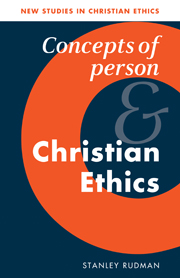Book contents
- Frontmatter
- Contents
- General editor's preface
- Acknowledgements
- List of abbreviations
- Introduction
- PART I ‘PERSON’ IN CONTEMPORARY ETHICS
- PART 2 ‘PERSON’ IN CHRISTIAN PERSPECTIVE
- PART 3 IMPLICATIONS FOR A CHRISTIAN ETHIC
- 11 A communicative ethic: Hauerwas and Habermas
- 12 A community of ethical difference: including the ‘other’
- 13 The logic of superabundance: an ethic of forgiving love
- 14 Rights and persons: the religious ground of human rights
- 15 The integrity and transformation of creation
- Conclusion
- Notes
- Select bibliography
- Index of subjects
- Index of names
15 - The integrity and transformation of creation
Published online by Cambridge University Press: 02 December 2009
- Frontmatter
- Contents
- General editor's preface
- Acknowledgements
- List of abbreviations
- Introduction
- PART I ‘PERSON’ IN CONTEMPORARY ETHICS
- PART 2 ‘PERSON’ IN CHRISTIAN PERSPECTIVE
- PART 3 IMPLICATIONS FOR A CHRISTIAN ETHIC
- 11 A communicative ethic: Hauerwas and Habermas
- 12 A community of ethical difference: including the ‘other’
- 13 The logic of superabundance: an ethic of forgiving love
- 14 Rights and persons: the religious ground of human rights
- 15 The integrity and transformation of creation
- Conclusion
- Notes
- Select bibliography
- Index of subjects
- Index of names
Summary
One of the underlying themes in our discussion of personhood has been its consequence in a communicative ethic which recognises the importance of relationships and difference as well as of universality and reason. Unless relationality can be extended to the whole of creation, however, an ethic which emphasised personhood would do little to alleviate our environmental and ecological problems. The intention of this chapter, therefore, is to illustrate how a Christian communicative ethic holds together the human and the non-human, the origin and the end of creation, suffering and glory, beckoning to a transformation of all things in Christ.
In considering the implications of personhood for a Christian ethic, we have referred to love of neighbour/enemy, forgiveness and rights/responsibilities. There are also ecological consequences. God's relation to the world as creator matters greatly both to God and the world. Human beings are part of a vast eco-system of incredible beauty and great intricacy which includes all living creatures, all plants, flowers and trees, all rocks, soil, water and air. It has become clear, however, that our planet is in deep trouble. The massive impact of modern technology on all forms of life is being experienced in traditional as well as so-called advanced industrial societies. Ecological pollution is perhaps the clearest sign of this impact.
Although there is some disagreement about details and about the policies needed to effect change, the scientific community, along with others, has voiced its concern about the problems of population growth, land, sea and air pollution, the over-rapid use of non-renewable energy resources, the destruction of the rain forests, the irreparable loss of wildlife species, the occurrence of pesticides in the food chain, the safe storage of toxic and nuclear waste, the thinning of the ozone layer and climatic changes triggered by material human developments.
- Type
- Chapter
- Information
- Concepts of Person and Christian Ethics , pp. 321 - 334Publisher: Cambridge University PressPrint publication year: 1997



